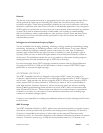NOOK User Guide Policies 220
Customer liquidated damages in the amount of five dollars (US$5.00) for each piece of ‘spam’
or unsolicited bulk email transmitted from or otherwise connected with Customer’s account, in
addition to any other rights and remedies AT&T my have in contract, law and equity.
Security Violations
It is Customer’s responsibility to ensure the security of its network and the machines that connect
to and use IP Service(s). You are responsible for configuring and securing your services to prevent
damage to the AT&T network and/or the disruption of Service(s) to other customers, and ensuring
that your customers and users use the Service(s) in an appropriate manner. Customer is required to
take all necessary steps to manage the use of the IP Service(s) in such a manner that network abuse
is prevented or minimized to the greatest extent possible. It is Customer’s responsibility to take
corrective actions on vulnerable or exploited systems to prevent continued abuse. Violations of
system or network security are prohibited and may result in criminal and/or civil liability.
AT&T IP Services may not be used to interfere with, to gain unauthorized access to, or otherwise
violate the security of AT&T’s or another party’s server, network, personal computer, network
access or control devices, software or data, or other system, or to attempt to do any of the
foregoing. Examples of violations of system or network security include but are not limited to:
intercepting, interfering with or redirecting e-mail intended for third parties, or any form of network
monitoring, scanning or probing, or other action for the unauthorized interception of data or
harvesting of e-mail addresses;
hacking - attempting to attack, breach, circumvent or test the vulnerability of the user authentication
or security of any host, network, server, personal computer, network access and control devices,
software or data without express authorization of the owner of the system or network;
impersonating others in order to obtain another user’s account password or other personal
information.
using the IP Service(s) to deliver spyware, or secretly or deceptively obtain the personal information
of third parties (phishing, etc.), or engage in modem hi-jacking;
using any program, file, script, command or the transmission of any message or content of any
kind, designed to interfere with a terminal session or the access or use of the Internet or any other
means of communication;
distributing or using tools designed to compromise security, including cracking tools, password
guessing programs, packet sniers or network probing tools (except in the case of authorized
legitimate network security operations);
unauthorized monitoring of data or trac on any network or system without express authorization
of the owner of the system or network; this would include use of sniers or SNMP tools;
falsifying packet header, sender, or User information whether in whole or in part to mask the
identity of the sender, originator or point of origin;


















